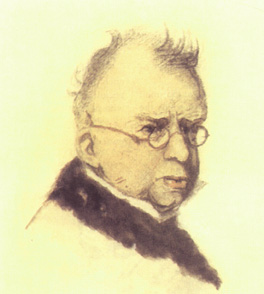George Chinnery's times were times of change.
In 1825, when the artist arrived at the small enclave, the effects of the impact brought by the establishment of liberalism in Portugal were felt in the city, though lessened by distance and by a different context. The ideological confrontation which would take place among the leading figures of royal absolutism and the defenders of the winds of change of History in the territory, was just the visible tip of the iceberg which concealed the underground struggle for control of Macao's economic and political supremacy.
The main contexts conditioned the city's daily life:
—that of the Portuguese Kingdom, which from 1820 onwards got involved in frequent political crisis and from where precise and un-equivocal instructions would not come;
—that of the Middle Kingdom, the interference of which was constant and oppressive, especially in the south region where the mandarins who protected Macao ruled;
—that of British interests in Far East Asia with their undeniable desire for expansionism. The latter was translated into putting pressure on increasing tea imports to be bartered for opium, and into a covetousness for Macao's port, which allowed the circulation of people and goods towards Guangzhou.
 Self-Portrait
GEORGE CHINNERY (°1774-†1852)Pencil on paper.
In: HUTCHEON, Robin, Chinnery, Hong Kong, FormAsia, 1989, ill. p.87 - left.
Self-Portrait
GEORGE CHINNERY (°1774-†1852)Pencil on paper.
In: HUTCHEON, Robin, Chinnery, Hong Kong, FormAsia, 1989, ill. p.87 - left.
Thus the outline of a great Sino-British conflict began to be drawn, the breaking-point of which was attained between 1839 and 1841, when the first Opium War and Hong Kong's cession took place. Macao, caught up between the powerful Middle Kingdom and powerful British claims, shielded itself with a show of tranquil neutrality. However, Macao needed to define its exact position in respect of Goa and the Portuguese Kingdom, of China and of the growing centripetal force of the British colony. This would take shape thanks to a decree in 1844, which gave autonomy to the Portuguese Territory in relation to Goa by means of the establishment of a free port in 1845, and which freed goods from customs duties entering Macao, but above all by the political actions of Governor Ferreira do Amaral, who between 1846 and 1849 put an end to all the vestiges of latter Chinese domination in Macao.
Once the changing context has been delineated, there are two other issues to be considered:
— how the large Chinese population, which was a majority in the enclave, underwent visible social structural changes resulting from the social structural changes which occurred during the decades of the Thirties and the Forties of the nineteenth century in the West;
— how George Chinnery, a British citizen, adapted himself to life in this Portuguese colony during twenty seven years till his death in 1852, where games of power and influence would come one after the other.
The artist's work might help answer these issues. An analysis of his drawings and paintings leads us to conclude that he turned his attention to the anonymous people of the settlement in their daily labour and their entertainments and movements, to the spaces, the landscapes, the maritime life and monuments of Macao. With the exception of portraits he was commissioned, he rarely dealt with the'beautiful people' of that epoch. In other words, the social transformations which took place during the mid nineteenth century did not correspond immediately to any significant alteration of the Chinese way of life and George Chinnery lived in the city phlegmatically, indifferent to the oscillations of local politics. Thus he was able to depict through his unequaled lines and colours the true and real Macao of the nineteenth century.
Though he is not a Macanese, having taught some Macanese artists such as Marciano Baptista, George Chinnery remains a must as an aesthetic reference in Macao, and with added value, as other winds of change are nearing inexorably towards the Territory at the end of this century. **

Self Portrait
GEORGE CHINNERY (°1774-+| 1852)Pencil and watercolour on paper. 90 x 100 mm. Mr and Mrs. Thompson collection
In: HUTCHEON, Robin, Chinnery, Hong Kong, FormAsia, 1989, ill. p.87 - right.
** Revised reprint of:
OLIVEIRA, Celina Veiga de, Foreword, in "George Chinnery: Imagens de Macau Oitocentista / George Chinnery: Images of Nineteenth-Century Macao", [Trilingual Exhibition Catalogue: 11 Out./Oct.- 18 Nov., 1997— Centro de Actividades Turísticas: Fórum de Macau / Tourist Activities Centre: Macao Forum], Macau, Comissão Territorial de Macau para as Comemorações dos Descobrimentos Portugueses / The Macao Territorial Commission for the Commemoration of Portuguese Discoveries, 1997, pp. 18-19.
* Coordinator of the 'George Chinnery' exhibition.
start p. 153
end p.